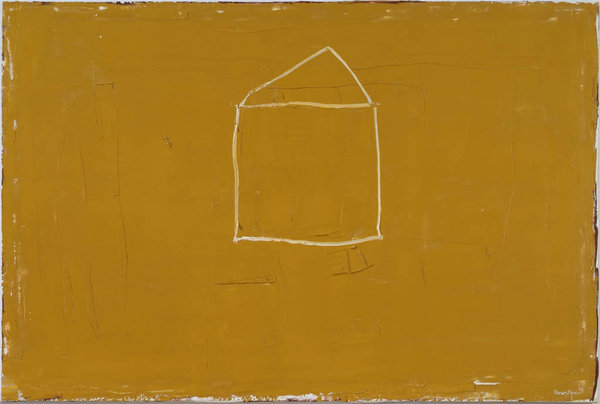Joan Hernandez Pijuan
dal 20/4/2010 al 24/6/2010
Segnalato da
20/4/2010
Joan Hernandez Pijuan
Baukunst Galerie, Koln
Paintings and works on paper

On Wednesday, the 21st of April 2010 from 6 to 8 p.m. the Baukunst Galerie opens the first posthumous solo-exhibition with paintings and works on paper of the Spanish artist Joan Hernández Pijuan in Germany. During his lifetime the gallery already organised two major solo-shows in 2000 and 2002. Dr. Martin Engler, head of painting and sculpture after 1945 at the Städel Museum in Frankfurt will give a short introduction in Hernández Pijuan's œuvre. The current exhibition provides an overview of large and medium sized works in oil on canvas from 1986 to 2005 as well as originals and graphic art on paper from 1982 to 2004.
Joan Hernández Pijuan was born in Barcelona in 1931. From 1952 to 1956 he studied at the Escuela Superior de Bellas Artes Sant Jordi in Barcelona and returned as an university lecturer in 1976. Beside his artistic work in Barcelona and at his country estate Folquer he accomplished his thesis about "Painting and Space: A Personal Experience". In 1989 he received a professorship for painting at the Faculty of Fine Arts at the University of Barcelona, which appointed him to a dean in 1992. In 2005 Pijuan is awarded the "Premi Ciutat de Barcelona" of Plastic Arts and the National Award of Graphic Arts. Before Joan Hernández Pijuan dies in the same year at the peak of his career in his hometown Barcelona, he presents his works already for the second time at the 51st Venice Biennale at the Italian pavilion.
Since the 60s Joan Hernández Pijuan's works are represented in the collections of several international museums, amongst others at the Museo Nacional Centro de Arte Reina Sofía in Madrid, the Museu d’Art Contemporani de Barcelona (MACBA), the Metropolitan Museum in New York and the Museum of Modern Art (MOMA) in New York. Remarkable solo-exhibitions have been organised e.g. in 2000 by the Rupertinum in Salzburg, from 2003 to 2004 by the Museu d’Art Contemporani de Barcelona (MACBA) and the Malmö Konsthall, in 2008 by the museums of the Fundación Juan March in Cuenca and in Palma de Mallorca and this year by the Fundació Suñol in Barcelona. The next major retrospective exhibition is scheduled by the Museo Nacional Centro de Arte Reina Sofía in Madrid for 2012.
The subject "landscape" takes the center stage in the works of Joan Hernández Pijuan: landscape as an idea revitalised by painting, as a painted transcription of a chronological and physical distant memory, which is turned into an exclusive visual entity by the fragmentary character of the pictorial process. In his works perambulated landscapes in Folquer, Évora, Comiols, La Segarra, Granada and Marocco are iconographically characterised. Unforgettable components of the received impressions are caught in a few lines, spaces and colours.
His colour palette is geared to the colours of nature: earthy ochre as the barren land, juicy green as the blossoming vegetation in spring, white as the dazzling sunshine at noon, black and red-brown as the rocks and clay bricks, bright yellow as the corn fields in autumn and delicate rose as the gentle sunset light. In his individual compositions he apparently reduces his chart of colour range to two or three shades, but several layers of different, superposed colours show through beneath. The oil paint is applied in pastose coats with a palette-knife. Below the monochrome surface the deeper colour layers shine through – almost unrecognisable in the centre of the painting and obvious at the edges, which generates a pictorial frame. Pijuan imprints his drawings with a carbon or the shaft of his brush in the soft and wet ground of the paint or applies the drawing in a contrasting colour on its surface. In a spontaneous and at the same time highly concentrated gesture he puts lines, marks and ornaments on the canvas without removing his hand from the canvas. Thereby he creates an imagery of his own origin, which derives its expressivity from strict reduction. Pijuan's signs are elementary. They are shapes and silhouettes with an evocative ability as waves, rhombi, leaves, houses, clouds, roads and hills, which are affected by empirical impressions of concrete landscapes.
Thus in the first instance his works are a pictorial discourse. In the serial rhythm of their rich and sensual materiality the afforded time of the creating process is inscribed as a chronological factor. Furthermore in several paintings he includes the outline of a frame, which substantiates and visualises in addition to the deeply carved layers of paint and the frontal, fragmentary spatial concept the pictorial space. This way his œuvre reflects the medium of painting, its instruments and option to utilise the personal recollection as well as the universe cultural commemoration. These works visualise as lyrical, poetic fragments the painter’s primary perception of light, colour and space and initiate a dialogue between vacancy and occupation, subject and object, contemplative silence and rhythm, inner and outer reality. In an compelling way Joan Hernández Pijuan synthesises esthetical and empirical experience to complex masterworks of simplicity.
Image: La Casa Ocre, 2004-05, oil on canvas 100x150cm
Opening Wednesday, the 21st of April 2010 from 6 to 8 p.m
Baukunst Galerie
Theodor-Heuss-Ring 7 D - 50668 Cologne
Opening hours:
Tue-Fri 10 a.m. - 6.30 p.m.
Sat 11 a.m. - 6 p.m.
and by appointment



